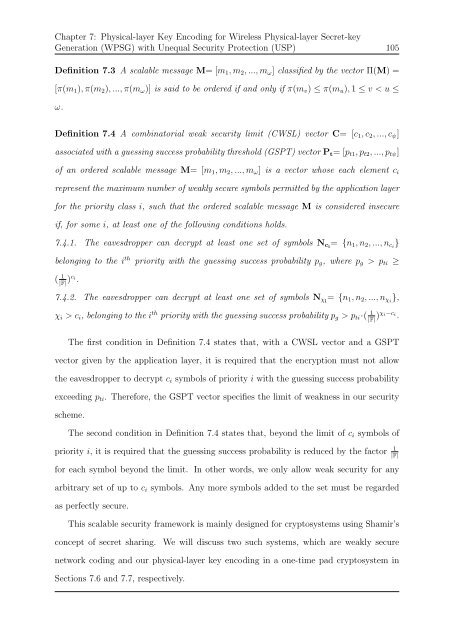Network Coding and Wireless Physical-layer ... - Jacobs University
Network Coding and Wireless Physical-layer ... - Jacobs University
Network Coding and Wireless Physical-layer ... - Jacobs University
You also want an ePaper? Increase the reach of your titles
YUMPU automatically turns print PDFs into web optimized ePapers that Google loves.
Chapter 7: <strong>Physical</strong>-<strong>layer</strong> Key Encoding for <strong>Wireless</strong> <strong>Physical</strong>-<strong>layer</strong> Secret-key<br />
Generation (WPSG) with Unequal Security Protection (USP) 105<br />
Definition 7.3 A scalable message M= [m 1 , m 2 , ..., m ω ] classified by the vector Π(M) =<br />
[π(m 1 ), π(m 2 ), ..., π(m ω )] is said to be ordered if <strong>and</strong> only if π(m v ) ≤ π(m u ), 1 ≤ v < u ≤<br />
ω.<br />
Definition 7.4 A combinatorial weak security limit (CWSL) vector C= [c 1 , c 2 , ..., c ψ ]<br />
associated with a guessing success probability threshold (GSPT) vector P t = [p t1 , p t2 , ..., p tψ ]<br />
of an ordered scalable message M= [m 1 , m 2 , ..., m ω ] is a vector whose each element c i<br />
represent the maximum number of weakly secure symbols permitted by the application <strong>layer</strong><br />
for the priority class i, such that the ordered scalable message M is considered insecure<br />
if, for some i, at least one of the following conditions holds.<br />
7.4.1. The eavesdropper can decrypt at least one set of symbols N ci = {n 1 , n 2 , ..., n ci }<br />
belonging to the i th priority with the guessing success probability p g , where p g<br />
> p ti ≥<br />
( 1<br />
|F| )c i<br />
.<br />
7.4.2. The eavesdropper can decrypt at least one set of symbols N χi = {n 1 , n 2 , ..., n χi },<br />
χ i > c i , belonging to the i th priority with the guessing success probability p g > p ti·( 1<br />
|F| )χ i−c i<br />
.<br />
The first condition in Definition 7.4 states that, with a CWSL vector <strong>and</strong> a GSPT<br />
vector given by the application <strong>layer</strong>, it is required that the encryption must not allow<br />
the eavesdropper to decrypt c i symbols of priority i with the guessing success probability<br />
exceeding p ti . Therefore, the GSPT vector specifies the limit of weakness in our security<br />
scheme.<br />
The second condition in Definition 7.4 states that, beyond the limit of c i symbols of<br />
priority i, it is required that the guessing success probability is reduced by the factor 1<br />
|F|<br />
for each symbol beyond the limit. In other words, we only allow weak security for any<br />
arbitrary set of up to c i symbols. Any more symbols added to the set must be regarded<br />
as perfectly secure.<br />
This scalable security framework is mainly designed for cryptosystems using Shamir’s<br />
concept of secret sharing. We will discuss two such systems, which are weakly secure<br />
network coding <strong>and</strong> our physical-<strong>layer</strong> key encoding in a one-time pad cryptosystem in<br />
Sections 7.6 <strong>and</strong> 7.7, respectively.

















